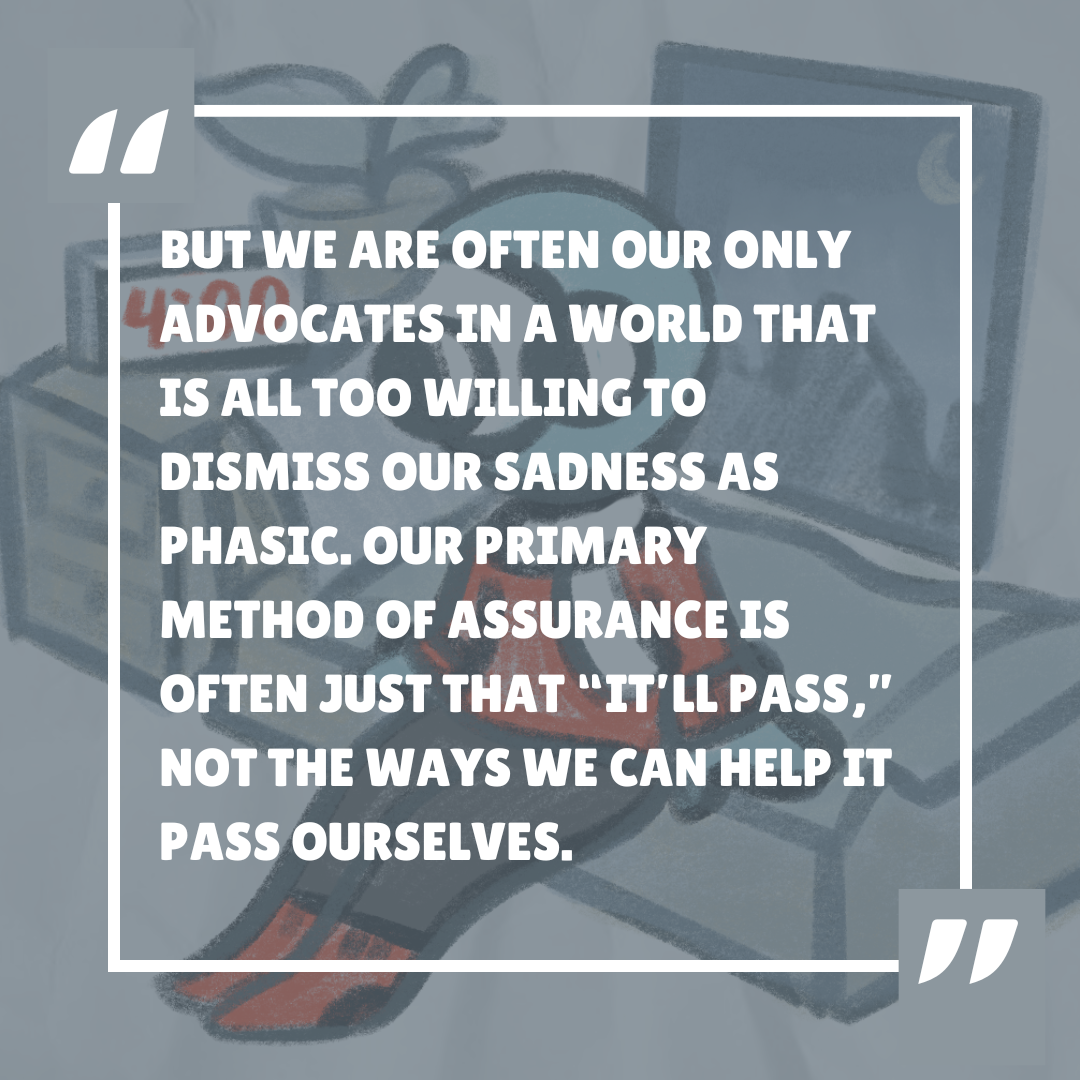Every day at school feels more drawn-out than usual. Layering hoodies never feels like enough — I cycle through the same few I own and keep reminding myself to buy gloves, although of course I never follow up on that. On overcast days, it feels as though the sun has set by noon. Even free periods in the roomy Student Union feel bleak, shot through by some winter curse. As soon as I restart my walking routines in the beginning of the school year, I dread the weeks where I’ll be watching my shadow lengthen and pretending it’s still August. That’s where we are now.
November has its merits — falling leaves form pretty scenes outside my window, and Thanksgiving is a much-needed break. But the combination of finals week looming and chilly weather (for California, anyway) makes it difficult to want to do anything but hide under the covers. It’s like the lethargy of winter has possessed us, crawling into our bones like a tardy Halloween ghost.
I’ve heard people use a term for this feeling: seasonal depression.
It’s one of those psychological terms that have slowly diverged from its medical meaning. The definitive feeling of a term used for diagnosis — even without a diagnosis itself — can be comforting. Colloquially, seasonal depression is used to refer to the feelings winter months bring: empty, distant and lonely.
However, Cleveland Clinic draws a difference between what we commonly know as seasonal depression and “winter blues” — while winter blues are a general feeling of being down during the colder months, seasonal affective disorder (unfortunately abbreviated as SAD) is a type of depression that affects people during certain parts of the year. Even though we perceive conditions like SAD as applying mainly to winter, people can also struggle with it during the summer.
Obviously, not everyone who gestures to seasonal depression intends to diagnose themselves, but the way we hold onto terms used for diagnosis is indicative of a wider problem. We’re constantly looking to banish our “negative” feelings to certain, predictable periods of time, seasons or not. How many times have you heard someone second-guess intense moods knowing their period is around the corner? And how many times have people around them accepted this as a complete answer?
I do this too. I’m a little too familiar with reacting to the feeling of inexplicable dread by thinking it’s just a hormonal issue or something about the weather being cold. But I’m inevitably disappointed when I check and find that my period is too far away to be an excuse because it’s reassuring to be able to put something as strange and elusive as sadness into a predictable pattern. Our lives follow cycles so often, so why shouldn’t our sadness?
External factors undeniably influence our mood — after all, winter blues themselves are considered a milder form of SAD. But we are often our only advocates in a world that is all too willing to dismiss our sadness as phasic. Our primary method of assurance is often just that “it’ll pass,” not the ways we can help it pass ourselves.
While we can’t escape winter early like Punxsutawney Phil, we can certainly work towards alleviating the winter blues. It’s tempting to hole up and start locking in for finals, but small steps to keep you feeling good will go a much longer way than staring at your computer for an extra 15 minutes. Take advantage of the fading sunlight by making time for a walk or sitting outside during a break period. Serotonin, which stabilizes our mood, is dependent on how much sun we get, so making sure we take in sunlight can be extremely helpful.
It’s also tempting to sideline our relationships in the process of trying to be productive, but putting in the effort to arrange time with friends in the last few weeks of this semester will be crucial. The process of planning can feel tedious, and staying in for as long as possible certainly feels tempting — everyone I’ve ever had plans with probably has a story about me being late and passed out in bed, but when I pull it together and follow through, those plans have always been worth it.
In particular, MVHS students have a persistent aversion to admitting they need to slow down sometimes. Often, less daytime functions as an excuse to stay inside and push ourselves even more. Realizing that we might be moving too fast for our sleep, social life or mental health to keep up is difficult, but we all deserve balance — winter is a common time for students to forget that.
It’s normal to experience the winter blues, but misleading to emphasize the “winter” part. Blues are going to happen no matter what part of the year or what part of our lives we’re in — we can learn to address them head-on.










